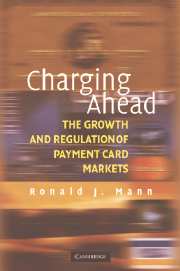Book contents
1 - Paper or Plastic? The Functionality of Payment Systems
Published online by Cambridge University Press: 06 July 2010
Summary
We live in a world of choices – sometimes seemingly endless choices. Some are important and some are meaningless. It is rational to make irrational choices some of the time, particularly in our capacity as consumers. In the grocery store, for example, after making “important” choices about what to cook in the coming week or whether to indulge the children with the new Star Wars cereal, we have to decide trivial things like how we want our groceries packaged and how we want to pay.
Merchants have some say in how we pay, and sometimes their choices limit our choices as consumers. Even so, merchants often accept payment forms that have distinctively different advantages to themselves and to their customers. What could be an advantage to a merchant could be a disadvantage to a customer and vice versa.
Plastic cards are one of the many different payment forms that are common in developed economies. To understand their importance, it is helpful to discuss some of the distinctions between different types of payments and payment transactions. For present purposes, the most important distinctions are between cash and noncash payments, paper and electronic payments, in-person and remote payments, and universal and networked payments.
Cash and Noncash Systems
Payments can be cash or noncash systems. The benefits of cash are obvious. It is widely accepted as payment. In the United States, creditors act wrongfully if they refuse to accept U.S. coins or currency when offered to discharge an obligation.
- Type
- Chapter
- Information
- Charging AheadThe Growth and Regulation of Payment Card Markets around the World, pp. 9 - 19Publisher: Cambridge University PressPrint publication year: 2006

